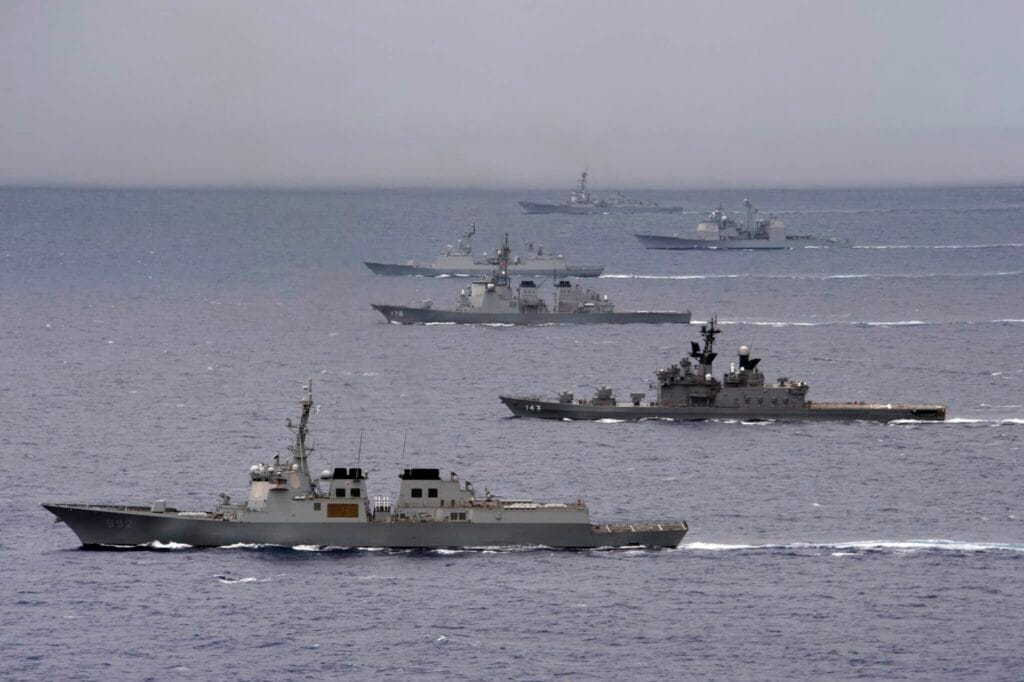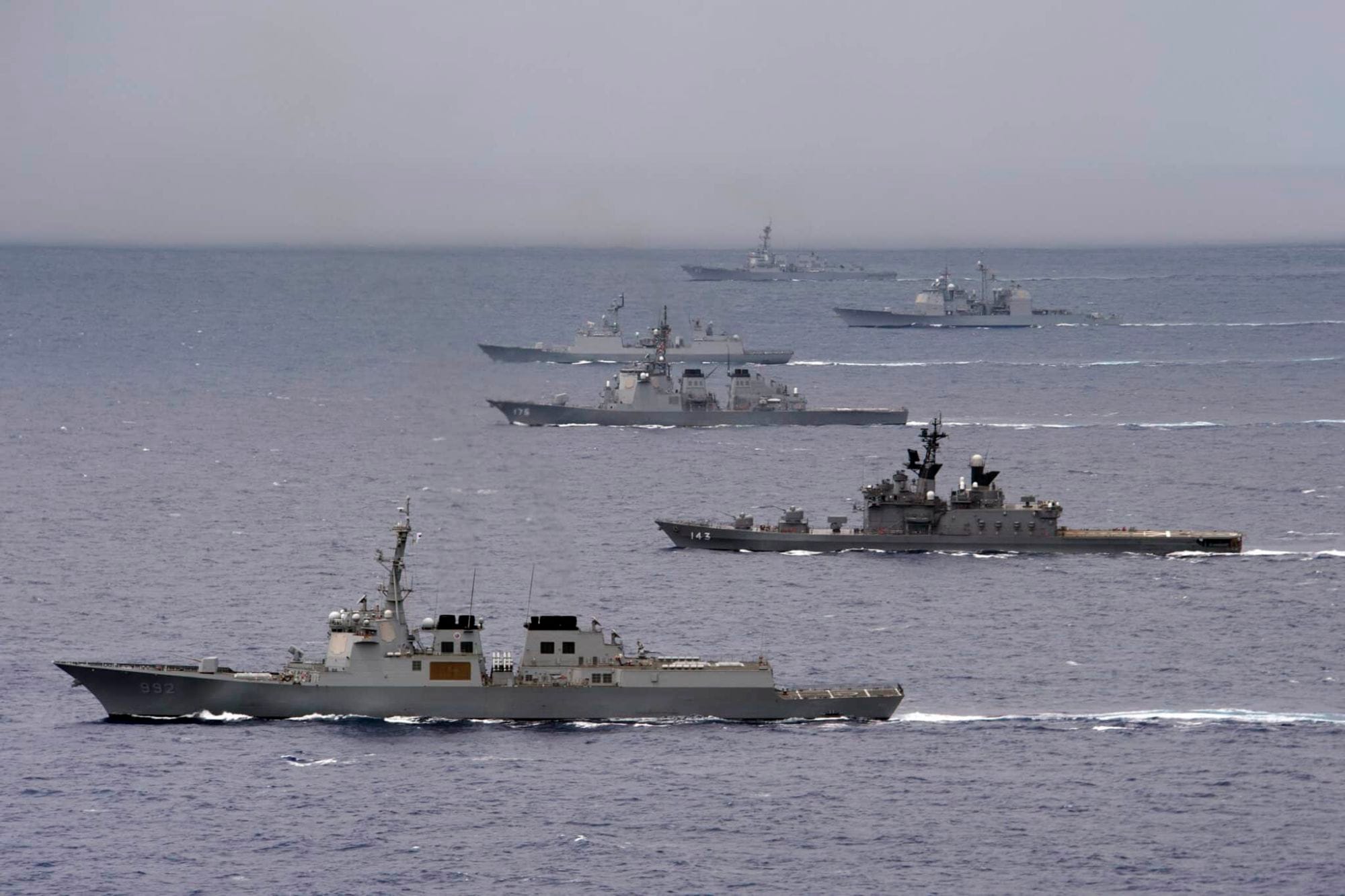The Freedom Edge exercise by the U.S., South Korea, and Japan escalates Korean Peninsula tensions, showcasing advanced trilateral military drills amid North Korea warnings.
Tensions are mounting on the Korean Peninsula as the United States, South Korea, and Japan launch the Freedom Edge exercise, a high-stakes military drill near South Korea’s Jeju Island.
Scheduled to continue through Friday, the exercise spans air, naval, and cyber operations, aiming to strengthen the allies’ joint defense capabilities in the face of North Korea’s expanding nuclear and missile programs.

South Korea’s Defense Ministry emphasized that the Freedom Edge exercise is designed to improve interoperability among the three nations’ forces.
Activities include maritime operations, ballistic missile defense drills, medical evacuations, and complex air maneuvers.
U.S. Indo-Pacific Command described the exercise as “the most advanced demonstration of trilateral defense cooperation to date,” highlighting the integration of U.S. Marine Corps and Air Force assets with South Korean and Japanese military units.
North Korea swiftly condemned the drills. Kim Yo Jong, sister of North Korean leader Kim Jong Un, criticized the exercise, warning that the “reckless show of strength made by them in real action in the vicinity of the DPRK will inevitably bring bad results to themselves.”
Pyongyang has historically viewed U.S.-led drills as a direct threat, and its latest response reflects ongoing tensions on the peninsula.
In addition to Freedom Edge, the U.S. and South Korea are reportedly conducting a tabletop exercise called Iron Mace, which examines ways to integrate Washington’s nuclear capabilities with Seoul’s conventional forces.
While details remain unconfirmed, North Korea interprets the drill as further escalation, illustrating the cyclical nature of military provocations in the region.
Kim Jong Un’s government continues to prioritize alliances with countries that counterbalance U.S. influence.
Since Russia’s invasion of Ukraine, Pyongyang has reportedly sent troops and weapons, including artillery and ballistic missiles, to support Moscow—a claim based on multiple media reports, though official verification is limited.
Earlier this month, Kim attended a military parade in China alongside Chinese President Xi Jinping and Russian President Vladimir Putin, signaling a coordinated effort to strengthen diplomatic and military ties with key regional powers.
For the U.S., South Korea, and Japan, the Freedom Edge exercise is not only a display of military readiness but also a crucial deterrent strategy.
Officials argue that such drills reassure regional allies, protect vital maritime routes, and provide essential training in emergency scenarios.
By simulating complex operations, the exercises test emerging technologies, improve command coordination, and enhance rapid response capabilities against potential threats.
Observers note that North Korea often times missile tests and other demonstrations to coincide with allied drills, creating a cycle of action and reaction that perpetuates Korean Peninsula tensions.
Analysts caution that while exercises like Freedom Edge bolster deterrence, they also carry the risk of unintended escalation if misinterpreted by Pyongyang.
The exercise also underscores broader regional security concerns.
By demonstrating advanced trilateral defense cooperation, the allies send a clear message to other Indo-Pacific nations about their readiness to respond collectively to emerging threats.
This coordination provides reassurance not only to South Korea and Japan but also to regional partners such as Australia and ASEAN countries, who closely monitor U.S. military posture in the area.
Despite North Korea’s opposition, the Freedom Edge exercise continues as planned, with allied forces conducting live drills, integrated simulations, and emergency medical operations.
Military analysts suggest that the exercise reinforces both deterrence and defense, making it clear that while diplomatic channels remain open, allied forces are prepared to respond decisively to any provocations.
The Korean Peninsula remains one of the most volatile regions in the world, and the Freedom Edge exercise illustrates the delicate balance between preparedness and provocation.
While the drills enhance U.S.-South Korea drills capabilities and demonstrate sophisticated trilateral defense cooperation, they also heighten North Korea’s sense of threat, potentially influencing Pyongyang’s military planning.
The Freedom Edge exercise represents a multifaceted approach to regional security: it strengthens allied cooperation, tests critical operational capabilities, and signals deterrence to adversaries.
At the same time, it reminds the international community that tensions on the Korean Peninsula persist and that careful diplomacy remains essential to prevent escalation.
As the drills proceed, global observers and policymakers are watching closely.
The success of the Freedom Edge exercise may influence future strategic planning in the Indo-Pacific, demonstrating how coordinated allied operations can both enhance security and navigate the complex challenges posed by North Korea’s military ambitions.
.



